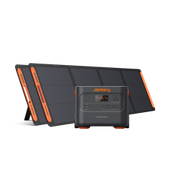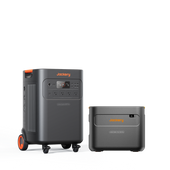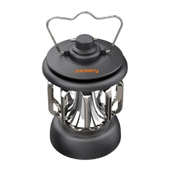Living off-grid liberates you from relying on the conventional electricity grid. Batteries are essential for off-grid living because they enable you to store electricity for later use. With batteries, living off-grid and relying primarily on renewable energy sources for your electricity requirements would be easier, as there would be no way to store the energy produced by these sources.
There are multiple batteries for solar off-grid, including lithium-ion, LiFePO4, lead acid batteries, and more. Each form of battery has its advantages and disadvantages. Choosing the correct battery type is essential for assuring the reliability of an off-grid solar system.
What Are Batteries for Solar Off-Grid?
Solar batteries inhabited remote campsites and mountaintop cabins before. Today, they are still essential for dry camping and boondocking, but as grid defection becomes increasingly popular, solar systems are making their way into many villages and cities.
People are migrating off-grid in areas where grid electricity is readily available. They are constructing solar-powered eco-friendly micro houses. In regions where the grid is frequently unreliable, others install solar panels on rooftops as reserve power. Some save substantial money by relying solely on solar energy, not the grid.
Therefore, batteries for solar off-grid must be more reliable, durable, and efficient than ever before.
Types of Batteries for Solar Off-Grid
Batteries for solar off-grid, which enable you to operate your appliances and electronics independently of the grid, are available in various compositions. Lithium-ion, LiFePO4, lead-acid, and nickel-cadmium batteries are commonly used in off-grid solar systems. Here is a summary of each type:
Lithium-ion Batteries are used extensively in various applications, including off-grid solar systems. They provide a high energy density, a small form factor, and exceptional round-trip efficiency. Lithium-ion batteries have more extended longevity than lead-acid batteries, providing dependable and durable energy storage, such as Jackery Portable Power Stations. Lithium-ion batteries are of the highest quality compared to other types of batteries.
LiFePO4 Batteries have acquired traction in off-grid solar systems. In comparison to other lithium-ion battery chemistries, they have a longer lifespan, greater energy density, and more excellent safety. LiFePO4 batteries, such as those found in the Jackery Explorer 2000 Plus, have a high cycle life, permitting repeated deep cycling without significant capacity loss.
Lead-acid Batteries have been utilized in off-grid solar systems for a long time. They are inexpensive and available in several variants, including flooded lead-acid (FLA), absorbed glass mats (AGM), and gel. The electrolyte levels of FLA batteries must be monitored and replenished regularly. On the other hand, AGM batteries do not require maintenance and have superior deep cycling capabilities.
Nickel-Cadmium Batteries have been present for decades. They have a long cycle life and a high discharge capacity and perform well in extreme temperatures. Concerns about the environmental impact of cadmium, as well as the emergence of more advanced battery technologies, have reduced their prevalence in recent years.
How To Do Batteries for Solar Off-Grid Work?
Solar batteries are a sensible investment for energy storage. Without a battery power station, your system cannot store energy for subsequent use.
Installing a solar battery with your solar panel system allows you to store excess solar energy rather than send it back to the power infrastructure. The excess can recharge your battery if your solar panels produce more electricity than you require.
You can use the stored energy to power your off-grid home even without better sunlight conditions. The electricity is only returned to the grid when the battery is full and drawn from the grid when the battery is depleted.
How Does A Jackery Power Station Work?
Jackery provides a variety of portable power stations for charging various appliances while living off the grid. Jackery Explorer Portable Power Stations provide consistent power to the off-grid, mainly when the power grid is down or when you participate in outdoor activities.
Jackery is a well-known manufacturer of superior solar energy systems and components, including solar panels, power stations, and solar generators. Jackery Portable Power Stations are ideal for use as a backup energy source when residing off-grid. One of the most significant benefits is their high energy density, which enables them to store enormous energy in a relatively small space.
The Jackery Portable Power Stations utilize pure, renewable solar energy to charge electronic devices off-grid. The Jackery Solar Panels absorb sunlight and convert it into electricity; the Portable Power Station stores and transfers the electricity for off-grid use. A portable power station is a battery-powered inverter generator with AC, DC, and USB connections.

Best Batteries for Solar Off-Grid
Solar panels are a miracle of modern technology that makes energy independence possible, but they would not be practical for energy independence if batteries were not present. Even in the most sunny states, the sun does not always beam. The following are the best batteries for solar off-grid.
Off-Grid Power Watts
When producing and supplying electricity, there may be no greener, more accessible, or more efficient technology than solar energy. A typical off-grid residence requires approximately 7kW (or 7000 Watts) of power to produce energy.
An adequate off-grid cabin will require between 5,000 and 7,000 watts of electricity, which can be determined by aggregating the operating hours of frequently used appliances. Solar panels, solar generators, and battery packs are all viable options for generating power.
|
Appliances |
Minimum Wattage |
Maximum Wattage |
|
Off-Grid Coffee Maker |
800W |
1400W |
|
Off-Grid Stove |
600W |
1700W |
|
Off-Grid Refrigerator |
100W |
200W |
|
Off-Grid Water Heater |
600W |
1700W |
|
Off-Grid Washing Machine |
450W |
600W |
|
Off-Grid TV |
17W |
60W |
|
Off-Grid Fan |
60W |
70W |
Best Batteries for Solar Off-Grid with Jackery
The batteries for solar off-grid solutions will be optimal depending on what you need to maintain running for off-grid living. The unit of measure for battery size or capacity is kWh (kilowatt-hours), the total energy a battery can store. Typically, the functional capacity is limited to 80 to 90 percent of the full battery capacity to prolong the battery's life and prevent a possible shutdown at deficient charge levels.
Jackery Explorer 5000 Plus Portable Power Station
The Jackery Explorer 5000 Plus Portable Power Station is the powerful, eco-friendly home backup charging solution ideal for living off-the-grid. It’s dual voltage support ensures you can charge various appliances, such as refrigerators, clothes dryers, etc., for long hours. It features 12 output ports to ensure you can charge multiple appliances simultaneously. It also supports add-on battery packs like Jackery Battery Pack 5000 Plus to extend the battery capacity from 5kWh to 60kWh.
Product Specs
- Capacity: 5040Wh Capacity, 7200W Inverter, 14400W Surge
- Output Ports: AC Output: (NEMA L14-30R/14-50) 120V/240V~60Hz, 30A, 7200W Max, AC Output(x4): 120V, 20A, 2400W, USB-A Output(x2): 18W Max, 5-6V⎓3A, 6-9V⎓2A, 9-12V⎓1.5A, USB-C Output(x2): 100W Max, 5V⎓3A, 9V⎓3A, 12V⎓3A, 15V⎓3A, 20V⎓5A, Cigarette Lighter Port: 12V⎓10A.
- Recharging Methods: 2*SolarSaga 500X completely charges the power station in 6.5 hours. Alternatively, the power station can be charged via an AC charging in 3.5 hours, smart transfer switch in 1.7 hours, and high-voltage PV charging in 1.7 hours.
- Design: The Jackery Explorer 5000 Plus Portable Power Station features an optimized CTB structure. It is equipped with a pull rod and double wheels to make transportation easier and more convenient.
Customer Review
“The Jackery Explorer 5000 Plus boasts an impressive energy capacity of 5180Wh, which allows for a wide array of needs. It is equipped with multiple output options, including AC, DC, and USB ports, ensuring compatibility with various gadgets and appliances. This versatility is particularly advantageous for users who require power for camping equipment, medical devices, electric vehicles, or during emergencies.” — Customer.
Jackery Explorer 3000 Pro Power Station
With a capacity of 3024Wh and a power output of 3000W, the Jackery Explorer 3000 Pro Portable Power Station is your SMART power ruler. The ideal power source for off-grid living, camping, RVs, and home applications, as it can charge 99% of the equipment for an extended period and can be controlled via an app.

The Explorer 3000 Pro power station is incredibly efficient to LIB, with an extraordinary 2,000 life cycle and up to 70% efficiency. It is a high-capacity battery pack for individuals who need to operate larger, higher-output loads or are in situations requiring a great deal of additional power. It can also function as a primary off-grid solar power system or a replacement for the off-grid electrical system.
The battery management system (BMS) of the Explorer 3000 Pro is capable of 80 million tests per second, ensuring that the battery is never overcharged or discharged. Its heat dissipation efficacy has also been enhanced by 30% due to the nine temperature sensors and adjustable ventilation speed.
Product Specs
- Capacity: 3024Wh Capacity, 3000W Inverter, 4400W Surge
- Output Ports: 5*AC outputs (120V, 60Hz 20A Max x 4, 120V, 60Hz 25A Max), 2*USB-A outputs (Quick Charge 3.0x2, 18W Max), 2*USB-C outputs (100W Max, 5V, 9V, 12V, 15V, 20V up to 5A), 1*car port (12V⎓10A).
- Recharging Methods: Using 6*SolarSaga 100W completely charges 6–7.5 hours instead of 2.4 hours using an electrical outlet. Alternatively, the power station can be charged via a portico.
- Design: The lightweight, compact, and space-saving design of the Jackery Explorer 3000 Pro features an aluminum alloy draw shaft and a non-slip silicone strip. Gain lightning-fast configuration and unparalleled charging efficiency.
Customer Review
“It arrived ahead of schedule and was carefully packaged. It performs as expected; it is straightforward to roll around and roughly the size of a salesperson's sample case. The unit has an optional mode that extends battery life by limiting maximum discharge and maximum charge to a narrower range than 0 to 100 percent of total capacity. ”
Jackery Explorer 2000 Plus Power Station
The Jackery Explorer 2000 Plus has an expandable capacity of 2 kWh to 24 kWh, which serves as the best battery for solar off-grid. Add a battery pack and solar panels to achieve 24 kWh of massive expansion. Ideal for living off the grid and providing power during protracted blackouts. It only takes 2 hours to charge with solar energy. Power is now wholly independent and can be set in just two hours.

2 kWh large capacity with up to 24 kWh extended electricity raises the bar for off-grid living. The capacity of a single Jackery Explorer 2000 Plus Power Station can be increased from 2 kWh to an exceptional 12 kWh with up to five add-on battery modules. 2* Jackery Explorer 2000 Plus Portable Power Stations may be connected in parallel to increase capacity to an astounding 24 kWh.
The first add-on battery pack in the industry can be charged using solar panels, allowing for greater flexibility and saving time and energy during the charging process. Even if used once a day, the superior LiFePO4 battery has a lifespan of up to ten years, as it was designed for durability.
Product Specs
- Capacity: 2kWh-24kWh Capacity, LFP (LiFePO4 battery)
- Output Ports: 5*AC outputs (4*AC Output: 120V~ 60Hz, 20A Max, 1*AC Output: 120V~ 60Hz, 25A Max, AC Total Output,3000W Max, 6000W surge peak), 2*USB-A outputs (Quick Charge 3.0, 18W Max), 2*USB-C outputs (100W Max, 5V, 9V, 12V, 15V, 20V up to 5A), 1*car port (12V⎓10A).
- Recharging Methods: Explorer 2000 Plus + SolarSaga 200W x 6 = 2H, Explorer 2000 Plus + SolarSaga 200W x 4 = 3.8H, Explorer 2000 Plus + SolarSaga 200W x 3 = 4.8H, Explorer 2000 Plus + SolarSaga 200W x 2 = 7H, Explorer 2000 Plus + SolarSaga 200W x 1 = 14H, AC adapter = 2H, Carport = 25H.
- Design: ChargeShield is Jackery's cutting-edge fast-charging technology, which features 62 protective mechanisms, 12 protective algorithms, and four varieties of physical safety protection. This technology improves safety and extends battery pack life by 50 percent using a novel variable-speed charging algorithm.
Customer Review
“I have used Jackery batteries for years. When the Explorer 2000 Plus was introduced, I was ecstatic. This product is the very first disposable battery system released by Jackery. It has a maximum capacity of 12kwh on a 3000w 120v output and 24kwh on a 6000w 240v output. Ideal improvement for my off-grid cabin.”
Jackery Explorer 2000 v2 Power Station
The Jackery Explorer 2000 v2 Portable Power Station has a battery capacity of 2042Wh, allowing it to charge multiple devices simultaneously. The Explorer 2000 is capable of charging 99% of essential appliances when you need power while camping or during an outage. Jackery Explorer 2000 v2 Portable Power Station can operate everything from microwaves to large refrigerators to air conditioners.

Product Specs
- Capacity: 2042Wh Capacity, 2200W Inverter, 4400W Surge
- Output Ports: AC Output(x3): 120V ~ 60Hz, 18.3A, USB-A Output(x1): 18W Max, 5-6V⎓3A, 6-9V⎓2A, 9-12V⎓1.5A, USB-C Output(x2): 30W Max, 5V⎓3A, 9V⎓3A, 12V⎓2.5A, 15V⎓2A, 20V⎓1.5A; 100W Max, 5V⎓3A, 9V⎓3A, 12V⎓3A, 15V⎓3A, 20V⎓5A, Car Port(x1): 12V⎓10A Max.
- Recharging Methods: The Explorer 2000 v2 can be fully charged from a dead battery in about 7.5 hours when using 2*SolarSaga 200W solar panels, 2 hours using an AC power outlet, and 24 hours using a carport.
- Design: The Explorer 2000 v2 power station, weighing approximately 17.9 kilograms (lbs), is designed with a foldable handle for portability.
Customer Review
“Purchased the 2000 v2 bigger brother. It came in very handy during a 5 day power outage at home. Ran the generator during the day and this all night. Worked a treat and kept the neighbours happy with the night time silence. Next one will be even bigger as a home backup solution!” — Lee D.
|
Series |
Capacity |
AC Output |
Off-Grid Appliances Watts |
Working Hours |
|
5040Wh |
7200W (14400W Peak) |
Coffee Maker: 800W-1400W Refrigerator: 100W-200W Water Heater: 600W-1700W Washing Machine: 450W-600W TV: 17W-60W Fan: 60W-70W |
Coffee Maker: 3.0H-5.0H Refrigerator: 17.1H-28.6H Water Heater: 2.4H-6.6H Washing Machine: 6.6H-8.6H TV: 38.9H-63.9H Fan: 35.7H-38.9H |
|
|
3024Wh (70Ah, 43.2V) |
3000W Max (6000W Peak) |
Coffee Maker: 800W-1400W Refrigerator: 100W-200W Water Heater: 600W-1700W Washing Machine: 450W-600W TV: 17W-60W Fan: 60W-70W |
Coffee Maker: 1.7H-3H Refrigerator: 11H-19.8H Water Heater: 1.4H-4H Washing Machine: 4H-5.2H TV: 29.2H-59H Fan: 26.1H-29.2H |
|
|
2kWh-24kWh |
3000W Max (6000W Peak) |
Coffee Maker: 800W-1400W Refrigerator: 100W-200W Water Heater: 600W-1700W Washing Machine: 450W-600W TV: 17W-60W Fan: 60W-70W |
Coffee Maker: 1.2H-2.0H Refrigerator: 7.4H-13.4H Water Heater: 1H-2.7H Washing Machine: 2.7H-3.5H TV: 19.7H-39.9H Fan: 17.6H-19.7H |
|
|
2042Wh |
2200W (4400W Peak) |
Coffee Maker: 800W-1400W Refrigerator: 100W-200W Water Heater: 600W-1700W Washing Machine: 450W-600W TV: 17W-60W Fan: 60W-70W |
Coffee Maker: 1.2H-2.1H Refrigerator: 7.8H-14.4H Water Heater: 1H-2.7H Washing Machine: 2.7H-3.6H TV: 21.7H-21.7H Fan: 19.3H-19.7H |
Please note that the actual runtime may vary and this calculation is for reference purposes only.
How to Choose Batteries for Solar Off-Grid?
Choosing the best batteries for solar off-grid is crucial for ensuring the reliability and efficiency of your energy storage system. Consider the following factors when making your decision.
Power Needs
Determine the required battery capacity and power output by evaluating your energy needs. Consider your solar system's scale, energy consumption, and peak power requirements.
Battery Lifespan
Battery longevity is an essential factor to consider. In general, lithium-ion batteries have a longer lifespan than lead-acid batteries. Evaluate the battery's expected cycle life and warranty to ensure they align with your long-term objectives.
Battery Maintenance
Consider the battery's maintenance requirements. Some batteries, such as lithium-ion, require minimal maintenance, whereas others, such as lead-acid, may require regular inspections and maintenance to perform at peak levels.
Efficiency
Consider batteries with a high round-trip efficacy, which measures how much energy can be stored and retrieved. Less energy is lost throughout the charging and discharging processes with greater efficiency.
Batteries for Off-Grid FAQs
The following shows the frequently asked questions about batteries for solar off-grid:
How big a battery do I need for off-grid living?
Batteries are a crucial component of any off-grid system because they store energy for subsequent use. Once you understand what to search for, such as battery life, cost, capacity, and efficiency, it is simple to select the ideal battery. The durability, portability, and security of Jackery Portable Power Stations make them suitable for off-grid use, and they can power various common off-grid appliances.

Before selecting a power station, estimating how much electricity your off-grid cabin will require is essential. Depending on your needs, choose from Jackery Portable Power Stations with capacities between 3000Wh and 240Wh. Here's how to calculate the charging time for your numerous off-grid devices:
If you want to know how long a Jackery Solar Generator can charge your device, you can use the Running Time Calculator on its product page. Visit the solar generator page that you would like to purchase and scroll down to the calculator. Simply input the device's wattage and hit enter to see an estimate. For instance, the Jackery Solar Generator 3000 Pro (3024Wh battery) can power a 200W freezer for about 12.1 hours. Note that the actual runtime may vary slightly from these estimates.
What is the best battery to use off-grid solar system?
Batteries are a crucial component of any off-grid system because they store energy for subsequent use. Once you understand what to search for, such as battery life, cost, capacity, and efficiency, it is simple to select the ideal battery.
If you reside permanently in an off-grid dwelling, you need a battery to meet your daily energy needs.
Our recommendation for the best off-grid battery is the Jackery Portable Power Stations with Lithium-Ion batteries and LiFePO4 batteries, which are the best batteries if you're looking for extended longevity and the ability to expand your system at an affordable price in the future. Jackery Explorer power stations have a collapsible handle for travel convenience. With the stroke of a button, you can enjoy a superior charging experience off-grid.
How to DIY an off-grid solar system?
DIY off-grid solar power kits make going off-grid simpler than ever. Using equipment to install a solar power system is simple and can save you at least half the cost of employing a professional.
These kits include all the necessary equipment, which is the same or greater than what solar companies use and is tailored to your specific requirements.
Jackery Solar Generators can serve as your off-grid solar system. There are several additional advantages to a solar kit, and you can easily set up and install your solar power system with just a little bit of knowledge.
Final Thoughts
Essential for your off-grid solar power system is a dependable and long-lasting battery. With so many options on the market, picking one is tricky. When searching for the best batteries for solar off-grid, it is essential to consider the specific requirements of your system.
Lithium-ion and LiFePO4 batteries are the finest off-grid batteries, outperforming all other battery types. It is superior to all other batteries and ideal for extended use. Jackery Portable Power Stations use lithium-ion and LiFePO4 batteries to facilitate ultra-fast solar charging for off-grid use.








































![[Add - on] Jackery Manual Transfer Switch for Explorer 5000 Plus - Jackery](http://www.jackery.com/cdn/shop/files/add-on-jackery-manual-transfer-switch-for-explorer-5000-plus-9017324.png?v=1754016782&width=170)



















































































![The Best Batteries for Solar Off-Grid [2025]](http://www.jackery.com/cdn/shop/articles/the-best-batteries-for-solar-off-grid-2025-8703780.png?v=1754017420)







Leave a comment